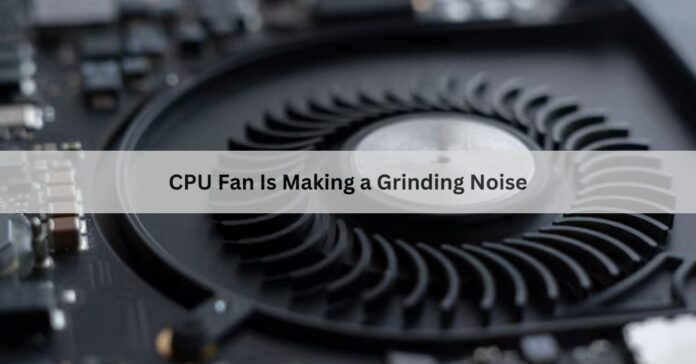I recently noticed my CPU fan was making a grinding noise, and it caught me off guard. After some quick troubleshooting, I found dust buildup was the culprit, and cleaning it resolved the issue. It was a relief to fix it myself and prevent potential overheating!
A CPU fan making a grinding noise is a common sign of dust buildup, worn bearings, or misalignment. Ignoring it can lead to overheating and hardware damage. Learn how to diagnose and fix the issue to protect your PC.
Stay tuned as we dive deep into the causes and solutions for CPU fan making a grinding noise. From quick fixes to preventive tips, we\u2019ll cover everything you need to keep your PC running smoothly!
Understanding the Role of a CPU Fan
The CPU fan is a critical component of your computer’s cooling system. It draws heat away from the processor, preventing thermal throttling and ensuring optimal performance.
Key components of a CPU fan include:
- Bearings: Enable smooth rotation.
- Blades: Move air efficiently across the heatsink.
- Motor: Drives the fan’s motion.
A malfunction in any of these parts can lead to grinding noises, signaling a problem that needs immediate attention.
Common Causes of Grinding Noises
- Dust and Dirt Accumulation Dust particles often settle on the fan blades and motor, disrupting their operation. Over time, this buildup causes resistance and produces grinding sounds.
- Bearing Wear and Tear Bearings are essential for smooth fan rotation. Prolonged usage can degrade them, leading to friction-induced grinding noises.
- Loose or Damaged Fan Blades Physical damage to the fan blades or improper installation can cause them to wobble or scrape against the frame, generating noise.
- Poor Alignment or Mounting Issues A misaligned fan or loose screws can cause vibrations and grinding sounds as the fan moves against adjacent components.
- Electrical Issues A malfunctioning fan motor or inconsistent power supply can disrupt fan performance, causing unusual noises.
Diagnosing the Problem
Visual Inspection Turn off your PC and open the case to inspect the fan for:
- Dust accumulation.
- Damaged or loose blades.
- Misaligned mounting.
Testing Fan Bearings Manually rotate the fan blades. Resistance or irregular motion indicates bearing issues.
Listening for Clues Grinding noises often vary in intensity. Persistent grinding usually points to mechanical damage, while intermittent sounds suggest dust buildup.
Using Diagnostic Software Tools like HWMonitor or SpeedFan can help you assess fan speed and identify irregular performance.
Read More : How Do I Know If My CPU Is Overclocked? A Comprehensive Guide 2025!
Step-by-Step Fixes for a Grinding CPU Fan
Cleaning the Fan and Surrounding Areas
- Tools Needed: Compressed air, a soft brush, and a microfiber cloth.
Steps:
- Turn off and unplug your PC.
- Use compressed air to blow out dust from the fan and heatsink.
- Gently clean the blades with a soft brush.
Tightening Loose Components
- Check the screws securing the fan to the heatsink or case.
- Tighten any loose screws to ensure proper alignment.
Lubricating or Replacing Fan Bearings
- Apply a small amount of machine oil to the fan’s bearings for smoother rotation.
- If the bearings are severely worn, replace the fan entirely.
Adjusting Fan Settings
Access your system’s BIOS or use fan control software to:
- Reduce fan speed if it’s running unnecessarily fast.
- Create custom fan curves for optimal performance.
Replacing a Faulty Fan
- Identify a compatible replacement fan by matching size and connector type.
- Disconnect the old fan and install the new one following the manufacturer’s instructions.
Preventive Measures
- Regular Maintenance: Clean your PC’s interior every 3-6 months to prevent dust buildup.
- Dust Filters: Install filters on your PC case to minimize debris entry.
- High-Quality Fans: Invest in fans with durable bearings for long-term reliability.
- Monitor Performance: Use diagnostic tools to regularly check fan speeds and temperatures.
When to Seek Professional Help
While most grinding noise issues can be resolved at home, consider seeking professional assistance if:
- The grinding noise persists despite cleaning and repairs.
- The fan motor or motherboard connections appear damaged.
- You’re uncomfortable handling delicate PC components.
FAQs
1. Can a grinding CPU fan damage my PC?
Yes, a malfunctioning fan can lead to overheating, which may damage your processor and other components.
2. How often should I clean my CPU fan?
Every 3-6 months, depending on your environment and usage.
3. What is the average lifespan of a CPU fan?
Most fans last 3-5 years, but high-quality models may last longer with proper maintenance.
4. Are grinding noises always caused by hardware issues?
Not always. Sometimes, incorrect fan speed settings can produce unusual noises.
5. What’s the cost of replacing a CPU fan?
Replacement fans typically cost $10-$50, depending on quality and brand.
Conclusion
Addressing a grinding CPU fan promptly is crucial for maintaining your PC’s performance and longevity. By identifying the cause and applying the appropriate fix, you can prevent costly repairs and ensure a smoother computing experience. Remember to follow preventive measures to avoid similar issues in the future.

